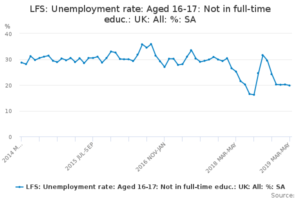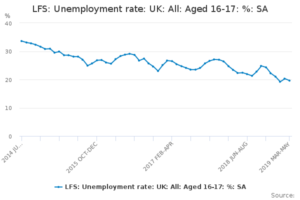The latest ONS data shows a continuation of promising figures for the health of the UK labour market. The new numbers for March – May 2019 showed an estimated 1.29 million people were unemployed, 116,000 fewer than a year earlier and 820,000 fewer than five years earlier.
A closer look at the 820,000 reduction of unemployed people over the last five years:
- People unemployed for up to six months fell by 246,000 to 766,000
- People out of work for between 6 and 12 months fell by 160,000 to 187,000
- Phe largest fall was for people unemployed for over one year (down 414,000 to 340,000)
Unemployment for ages 16-17
The latest unemployment rate for 16-17 year olds not in full-time education is 19.8%, a good figure when compared to the same 3 month data sample of 2014 which measured it at 28.7%. Even taken alone, although miles away from the 16-64 unemployment rate of 3.8%, this is far from being necessarily bad news. This is because the data measurement does not consider those in part-time education, part-time or full-time training, and so the decrease in unemployment for that sub-sample can at least be taken as definitively positive.
16-17 year old unemployment has decreased from 20.3% to 19.6% since the last 3-month measurement and is maintaining the trend of historic-lows. In relative terms, the level of unemployment for this age bracket has dropped by 16% since last year, continuing the positive trend of the past 5 years.
Unemployment for ages 18-24
The unemployment rate for those aged 18-24 has been gradually rising since the start of 2019, now 10.7% from 9.9% at the start of the year. Not much can be gained from this observation, as the previous 5 years of data show similar ups and downs yet maintain gradual improvement overall. Another example to consider to avoid drawing premature conclusions is the 18-24 unemployment rate for those not in full-time education: now 10.4% from 9.7% at the start of the year. In full context, 10.4% is still among historic lows as shown in the graph below.
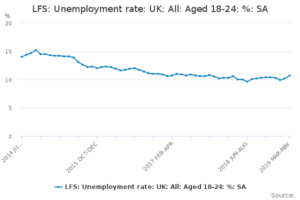
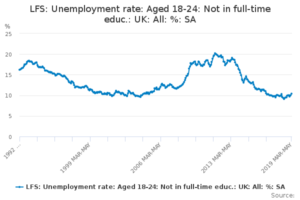
Similarly, the figures for unemployment in this age bracket lasting over 24 months have increased from 14,000 since the last 3 month measurement period to 17,000. Again, a look at the medium/long-term trends shows that this may be part of the granular ups and downs experienced over the past 5 years whilst maintaining a positive trend. We will have to see how this develops.
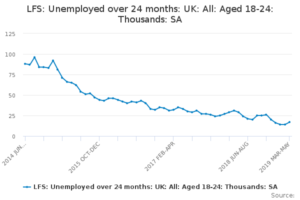
Main points for March to May 2019
- The UK employment rate was estimated at 76.0%, higher than a year earlier (75.6%); on the quarter, the rate was 0.1 percentage points lower, the first quarterly decrease since June to August 2018.
- The UK unemployment rate was estimated at 3.8%; it has not been lower since October to December 1974.
- The UK economic inactivity rate was estimated at 20.9%, lower than a year earlier (21.0%).
- Estimated annual growth in average weekly earnings for employees in Great Britain increased to 3.4% for total pay (including bonuses) and 3.6% for regular pay (excluding bonuses).
- In real terms (after adjusting for inflation), total pay is estimated to have increased by 1.4% compared with a year earlier, and regular pay is estimated to have increased by 1.7%.
Young People not in Education, Employment or Training (NEET): May 2019
The latest NEET data still comes from May 2019, with the next release due on the 22nd of August 2019.
- There were 764,000 young people (aged 16 to 24 years) in the UK who were not in education, employment or training (NEET); this number decreased by 24,000 from October to December 2018 and was down 34,000 when compared with January to March 2018.
- The percentage of all young people in the UK who were NEET was 11.0%; the proportion was down 0.3 percentage points from October to December 2018 and down 0.3 percentage points from January to March 2018.
- Of all young people in the UK who were NEET, 39.2% were looking for, and available for, work and therefore classified as unemployed; the remainder were either not looking for work and/or not available for work and therefore classified as economically inactive.
What the data doesn’t tell us
The economic forecast is characterised by ongoing uncertainty associated with the country’s preparation to leave the European Union. The economy grew by 0.3% in the three months to May 2019, with services and production contributing positively, whilst construction made no contribution to growth. The latest estimates show that labour productivity (measured as output per hour) for the three months to March 2019 decreased by 0.2% compared with the same period in 2018. This was a third consecutive quarter decrease.
The British Chamber of Commerce’s labour market survey for the period April to May 2019 (PDF, 366KB) showed that 51% of surveyed businesses that tried to recruit for high skilled positions in the previous 12 months reported average recruitment time exceeding three months. Over the same period, 16% of the businesses reported failing to receive apprenticeship applications, echoing the latest commentary from FE Week.


